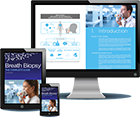Long-COVID fatigue reduced by over 50% in active individuals compared to sedentary
The ongoing coronavirus disease 2019 (COVID-19), caused by the severe acute respiratory syndrome coronavirus-2 (SARS-CoV-2) virus, has claimed more than 6.88 million lives worldwide. Many studies have reported the manifestation of long-COVID, which has been described as the persistence of COVID-19 symptoms for at least two months after diagnosis or one month after recovery from the acute illness, which requires hospitalization.
 Study: Physical Activity Effects on Muscle Fatigue in Sport in Active Adults with Long COVID-19: An Observational Study. Image Credit: p.ill.i / Shutterstock
Study: Physical Activity Effects on Muscle Fatigue in Sport in Active Adults with Long COVID-19: An Observational Study. Image Credit: p.ill.i / Shutterstock
Background
Breath Biopsy®: The Complete Guide eBook

Long-COVID can be categorized into two different forms, namely, prognostic and symptomatic. A serious form of long-COVID is the occurrence of thromboembolic complications, while a milder form is associated with dyspnea and muscle fatigue. Therefore, clinicians and scientists focussed on identifying the group most vulnerable to developing long-COVID and observed that individuals who developed severe infection were at a higher risk of persistent dyspnea and muscle fatigue/weakness for a prolonged period.
Notably, comorbidities, such as diabetes, cancer, obesity, and cardiovascular disease, associated with increased severity of COVID-19, were not linked with the onset of long-COVID-19. A recent study conducted in Italy revealed that most COVID-19 patients experience persistent fatigue, dyspnea, joint pain, and chest pain after being discharged from the hospital. A meta-analysis of 250,000 individuals also pointed out that the most persistent and common long-COVID symptoms were fatigue, sleep disturbance, dyspnea, and myalgia.
Based on the findings documented in several studies, fatigue is the most frequently reported Long-COVID symptom. Therefore, individuals, such as military and elite athletes, who were under routine physical performance monitoring were considered ideal candidates for long-COVID-19 research. These groups could be used to formulate treatments for long-COVID.
Myalgic encephalomyelitis or chronic fatigue syndrome (ME/CFS) is a complex multisystem disorder that causes extreme fatigue, orthostatic intolerance, cognitive deficits, and nonrestorative sleep. A common symptom of ME/CFS is difficulty in performing minimal exercises. Some of the symptoms of long-COVID and ME/CFS overlap, particularly persistent fatigue.
About the Study
A recent Diagnostics journal study determined the impact of physical activity on sleep, fatigue, and cognitive modifications in individuals affected by long-COVID. This study investigates how long-COVID differentially affects individuals with active lives from those with sedentary lifestyles.
A total of 506 participants were recruited, among which 138 were females. Many of the participants ski, which may be due to the proximity of the Dolomites mountain range. All participants had an active lifestyle and underwent an incremental stress test the year before contracting COVID-19 infection.
The participants were divided into four groups, namely, competitive cross-country ski athletes (AA), mountain amateurs (MA), ski instructors (SI), and sedentary people (SP). Participants belonging to the SP group were considered to be the control group. All participants experienced persistent muscle fatigue six months after the end of the COVID-19-positive period.
Study Findings
The current study cohort constituted a young population with a homogeneous lifestyle, i.e., an above-average degree of physical activity and experiencing long-COVID symptoms (muscle fatigue). Importantly, previous studies also reported this long-COVID symptom in pediatric and adolescent patients. A prominent biomarker related to training load is the level of TnC in the blood.
A Rating of fatigue (ROF) scale range between 1 and 10, where 10 represents maximum fatigue, was used in this study. At the end of the acute phase of COVID-19, the perception of fatigue among the participants, irrespective of gender and tested categories, was high, i.e., 8 on the ROF scale. Consistent with this finding, a previous study also reported that the study candidates experienced anxiety, muscle weakness or fatigue, sleep management difficulties, and depression six months after the end of the acute COVID-19 infection phase.
After one year of acute COVID-19 infection, a different observation was recorded, where AA, SI, and MA groups with higher motor efficiency indicated a ROF score close to 2. In contrast, those belonging to the sedentary group indicated a ROF value about twice as high. These findings indicate that individuals with a more active lifestyle experienced common long-COVID symptoms at a lower rate.
The current study observed that selected participants, irrespective of their gender, experienced a very high rate of fatigue along with other symptoms, such as memory and/or attention disorders, after six months from the end of the acute SARS-CoV-2 infection phase. In addition, the majority of participants reported non-restorative sleep.
Conclusion
The current study revealed that the perception of fatigue significantly reduced among physically active categories after one year of the acute phase of the disease. However, such reduction was not observed in sedentary people. A more extended observation period is required to understand whether fatigue may recur and in what manner.
- Coscia, F. et al. (2023) Physical Activity Effects on Muscle Fatigue in Sport in Active Adults with Long-COVID-19: An Observational Study. Diagnostics. 13(7), 1336. https://doi.org/10.3390/diagnostics13071336, https://www.mdpi.com/2075-4418/13/7/1336
Posted in: Men's Health News | Medical Condition News | Women's Health News | Disease/Infection News
Tags: Anxiety, Biomarker, Blood, Cancer, Cardiovascular Disease, Chest Pain, Chronic, Chronic Fatigue Syndrome, Coronavirus, Coronavirus Disease COVID-19, covid-19, Depression, Diabetes, Diagnostics, Dyspnea, Encephalomyelitis, Fatigue, Hospital, Joint Pain, Muscle, Myalgic Encephalomyelitis, Obesity, Pain, Physical Activity, Research, Respiratory, SARS, SARS-CoV-2, Severe Acute Respiratory, Severe Acute Respiratory Syndrome, Sleep, Stress, Syndrome, Virus

Written by
Dr. Priyom Bose
Priyom holds a Ph.D. in Plant Biology and Biotechnology from the University of Madras, India. She is an active researcher and an experienced science writer. Priyom has also co-authored several original research articles that have been published in reputed peer-reviewed journals. She is also an avid reader and an amateur photographer.
Source: Read Full Article



